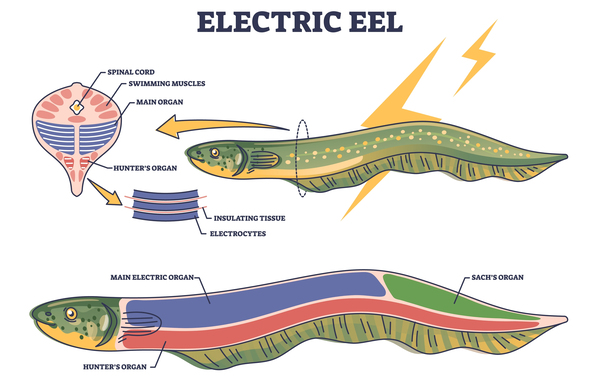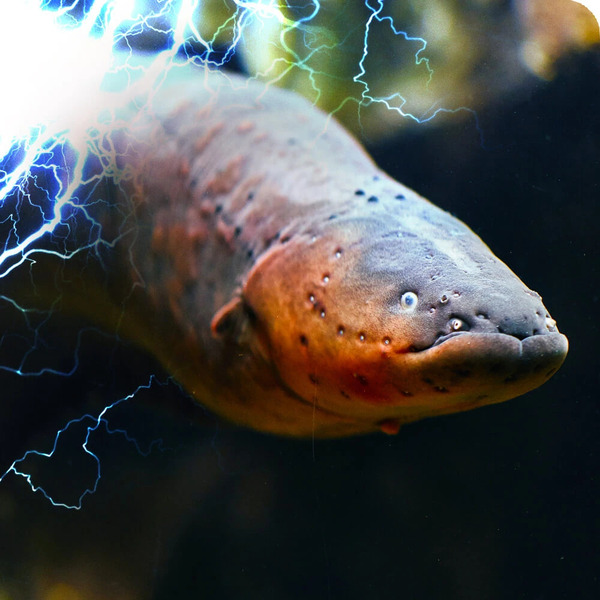The electric eel is a captivating creature that inhabits the murky waters of South America. Renowned for its remarkable ability to generate electricity, this fish is both awe-inspiring and unique. In this article, we’ll explore everything you need to know about electric eels, including their biology, habitat, behavior, and their fascinating role in genetic modification.

Despite its name, the electric eel (Electrophorus electricus) is not actually an eel; it belongs to the knifefish family. These intriguing fish can grow up to 8 feet long and are primarily found in the freshwater rivers and swamps of the Amazon and Orinoco basins. Their elongated bodies are dark on top and lighter underneath, providing effective camouflage in their natural habitat.
Electric eels are famous for their ability to produce electric shocks, which they use for hunting, navigation, and self-defense. They have specialized cells called electrocytes that function like tiny batteries. When these cells are activated, they create an electric current.

Electric eels can produce three main types of electric discharges:
Low-voltage discharges: Used primarily for navigation and communication, these pulses help the eels sense their environment.
Medium-voltage discharges: These are employed to stun prey, making it easier for the eel to capture its meal.
High-voltage discharges: The most impressive capability, these shocks can reach up to 860 volts—powerful enough to incapacitate larger animals, including humans, and are primarily used for self-defense against predators.
The electric shocks are generated through rapid, coordinated contractions of the electrocytes, allowing the eel to control the strength and duration of the discharge.

Electric eels thrive in slow-moving waters, such as rivers, lakes, and swamps. They prefer areas with dense vegetation, which provides both shelter and hunting grounds.
Electric eels are primarily nocturnal, meaning they are more active at night. During hunting, they emit low-voltage pulses to locate prey, which includes fish, amphibians, and even small mammals. This electro-sensory capability enables them to navigate their environment effectively and detect potential meals.
Electric eels have a unique breeding process. During mating season, males attract females by producing a series of electric signals. After mating, females lay thousands of eggs, which the males fertilize. Remarkably, the males guard the eggs until they hatch, displaying a level of parental care that is quite rare in fish.

Not true eels: As mentioned, electric eels are part of the knifefish family, not true eels.
Three recognized species: There are three species of electric eels, with the common electric eel being the most well-known.
Air-breathing fish: Electric eels can breathe air and must surface every few minutes, although they can hold their breath for about 15 minutes.
Resilience: They can survive in low-oxygen environments, thanks to their ability to breathe air.
While electric eels can deliver a powerful shock, they are not typically aggressive toward humans. However, it’s best to avoid contact with them in the wild, as their shocks can be dangerous, especially in water where other electrical devices might be present.
Beyond their impressive electrical capabilities, electric eels have recently been shown to play a surprising role in genetic modification among nearby organisms. Researchers at Nagoya University discovered that electric eels can induce genetic changes in nearby fish through a process similar to electroporation—a technique that creates temporary pores in cell membranes using electric fields, allowing DNA to enter target cells.
In experiments, researchers exposed zebrafish larvae to a DNA solution containing a glowing marker. When an electric eel discharged electricity, approximately 5% of the larvae showed markers indicating successful gene transfer. This discovery suggests that the electric discharge from the eel effectively facilitated the incorporation of environmental DNA into the larvae's cells, revealing an unexpected aspect of their ecological impact.
This research challenges the notion that electroporation is solely a laboratory phenomenon, opening new avenues for studying genetic modification in natural environments. The ability of electric eels to act as natural power sources may lead to genetic recombination in surrounding organisms, expanding our understanding of genetic processes in nature.
The findings have implications for biotechnology and genetic engineering, potentially leading to new techniques that harness the principles of natural electroporation. Understanding these mechanisms could inspire further research into other electrically active organisms and their roles in influencing genetic changes.

The electric eel is a remarkable creature that showcases the wonders of nature. With its ability to generate electricity, reaching up to 860 volts, and unique adaptations for survival, it remains one of the most intriguing fish in the world. Moreover, its unexpected role in genetic modification adds another layer of fascination to its story.
As we continue to study electric eels and their interactions with other species, we may unlock new insights into the complexities of life on Earth. This discovery not only highlights the electric eel's significance in the natural world but also inspires further investigation into the roles of natural electricity in biological processes. The electric eel stands as a testament to the surprises that nature holds, revealing that even the most familiar creatures can challenge our understanding of biology and genetics.
IntroductionElectric eels are fascinating creatures known for their ability to generate powerful electric shocks. But how dangerous are these shocks, and can an electric eel actually kill a human? In this article, we’ll explore the facts about electric eel shocks, their impact on humans, and how to stay safe around these electrifying animals.
What Is an Electric Eel?Electric eels (Electrophorus electricus) are not true eels; they’re a type of knifefish, more closely related to catfish than to other eels. They are native to South American rivers, especially in the Amazon and Orinoco basins, where they inhabit muddy waters. Electric eels can reach up to 8 feet in length and weigh around 44 pounds.
How Do Electric Eels Generate Electricity?Electric eels have specialized organs filled with cells called electrocytes, which produce electricity. By discharging these cells, an eel can generate shocks up to 600 volts—enough to power a large appliance for a few seconds. They use this electricity to navigate, communicate, stun prey, and defend themselves.
Can Electric Eel Shocks Kill a Human?While electric eel shocks are extremely painful and can be dangerous, they are unlikely to be fatal to a healthy adult under most circumstances. However, in certain situations, these shocks could lead to severe consequences, including death. Here’s how:
Multiple Shocks: Electric eels can deliver repeated shocks, which can quickly exhaust or incapacitate a person. If a person receives several shocks in succession, they might lose the ability to swim and potentially drown.
Cardiac or Respiratory Failure: The shock from an electric eel can interfere with the heart’s rhythm or impact breathing. While rare, this disruption could be fatal, especially if the person has a pre-existing heart condition.
Accidents and Injuries: A sudden, powerful shock can cause a person to lose control and suffer injuries, particularly if they’re in water where they might hit rocks or sharp objects.
Have Electric Eels Ever Killed Anyone?While electric eel fatalities are rare, there are documented cases of people dying after encounters with electric eels, usually from drowning due to shock-induced paralysis or muscle fatigue. Because electric eel habitats are generally remote, it’s difficult to verify many incidents, but experts agree the risk is real, though not common.
How to Stay Safe Around Electric EelsIf you’re swimming, fishing, or exploring rivers in South America, it’s important to be cautious. Here’s how to avoid a potentially dangerous encounter:
Stay Out of Murky Waters: Electric eels often inhabit muddy, slow-moving waters. Avoid swimming or wading in areas known for electric eel populations.
Avoid Nighttime Water Activities: Electric eels are often more active at night, so it’s wise to stay out of the water after dark in areas where they are found.
Observe from a Distance: If you spot an electric eel, maintain a safe distance. They are usually not aggressive, but they may defend themselves if they feel threatened.
What Should You Do if You’re Shocked by an Electric Eel?If you’re unfortunate enough to be shocked by an electric eel, here are a few steps you can take:
Stay Calm: Panic can worsen the situation, especially if you’re in water. Take deep breaths and try to regain control.
Get Out of the Water: The most immediate danger after a shock is drowning. Swim to safety as quickly as possible.
Seek Medical Attention: Electric shocks can have delayed effects on your muscles, nerves, and heart, so it’s a good idea to see a doctor even if you feel fine afterward.
Electric Eels and Human CuriosityElectric eels have long fascinated scientists and animal lovers due to their unique abilities. In recent years, researchers have used electric eels to understand more about bioelectricity, with potential applications in medicine and technology. While they pose some danger, electric eels are more likely to avoid humans than to attack.
So, can an electric eel kill you? The short answer is yes, but it’s unlikely. Electric eel shocks can be extremely painful, disorienting, and even dangerous, particularly if you’re in deep water. While the chances of a fatal encounter are low, it’s always wise to respect these creatures and take precautions in their natural habitats.
By understanding the behavior and abilities of electric eels, we can appreciate these remarkable animals while staying safe. Whether you’re an adventurer or just curious, knowing about electric eels can help you avoid any shocking surprises!
animal tags: electric-eel
We created this article in conjunction with AI technology, then made sure it was fact-checked and edited by a Animals Top editor.